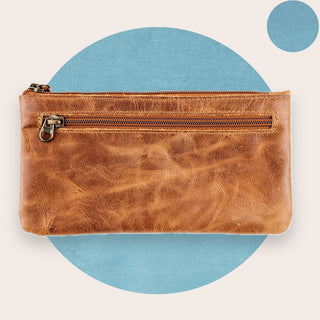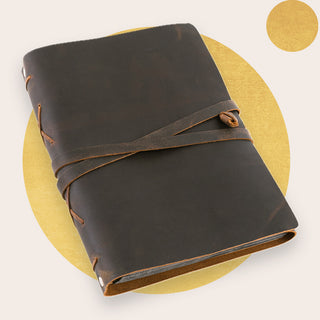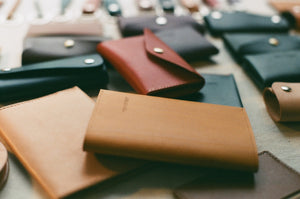Looking to hear what all the talk is about bonded leather? Well, you are in the right place!
Today, we will explore the ins and outs of bonded leather - what it is, how it is made, and why, through all its faults, it can sometimes be a force for good.
Well, what is it?
In essence, bonded leather is a type of leather that is constructed from scraps of leather rather than genuine leather in its purest form. It is not, however, faux leather, but rather occupies a place in between real leather vs fake leather.
This can actually be a really good thing, allowing smaller pieces of lower-grade leather to find a use in finished leather goods, thus encouraging a healthy cycle of recycling. This is also present in the way that older leather can be reconstituted in the same way, finding new use among a new audience. For this reason, bonded leather is sometimes referred to as reconstituted leather or blended leather.
Of course, constructing a final product (e.g., leather messenger bag) in this way has an effect on the functional and aesthetic properties of the leather. Some, however, scarcely know the difference anymore, a grain pattern impressed into the leather so that it mimics the true appearance of grain leather.

In this way, there is far more space for customization as well as the use of funky patterns. Sometimes, these color options are vivid and hallucinogenic.
All of this inevitably has an effect on the durability of the finished product, the leather aging, the action of shredding leather scraps and pulping them together rendering them weaker than real leather. The plastic-based materials used in the production are far less flexible than leather itself, meaning that bonded leather furniture and the like will only last a few years before cracking irreparably.
What is it Used for?
As already alluded to above, bonded leather is primarily used in the manufacturing process of the furniture industry. Though often found on sofas, this can also include just about any other piece of furniture upholstery that you can imagine.
Seeing as a whole sofa made from top grain leather would be incredibly expensive, furniture outlets thus offer more bonded leather furniture as a way for people to own a 'real leather sofa' more affordably.
Of course, this is a bit of a con - it does not bear thinking about comparing the performance between bonded leather vs real leather. Bonded leathers are formed of scrap leather. In this way, it is difficult to maintain a consistent quality throughout the process, so the quality of bonded leather varies far more.
This is, however, not only reserved for furniture, for bonded faux leathers also find their way into clothing and shoes of all varieties, not to mention all sorts of luggage and stationary to give the impression of expense.
How is Bonded Leather Made, then?
There are a number of steps to the process, actually, so listen closely:
1. Shredding
Yeah, that's right, shred those leather scraps and fibers nice and good until they are all ground up. There is very little in the way of discrimination at this stage of the process.
Rather any sort of unwanted leather is accepted, whether through excesses of certain batches of leather good production or from lower grade hides that might not have passed evaluation by the kinds of boards that are in charge of these things.
The process of constructing bonded leather is entirely unprejudiced in this way.
2. Mixing
Once shredded into a fine enough substance, the fibers are then mixed together with polyurethane plastic and/or a latex plastic mixture which binds them all together. This helps to hold all these separate fibers together once it has dried and solidified, at this point known as bonded leather pulp.
What is added to the mixture at this point depends entirely on the intended use of the finished leather product, whether it's a pair of shoes or a leather pencil case. They might, for example, need to be dense and firm, or indeed soft and plush. Many of these mixtures are kept as trade secrets by manufacturers so it is hard to tell exactly what goes on.

3. Extrusion
So, now that we have our bonded mixture, it is then extruded onto a flat surface while it is still relatively moist - either done via pouring or via specific machines that ensure an entirely even surface.
The material needs a secure place to dry and to be ready to take its final shape. This secure place is usually made from paper or another fiber like cotton and/or polyester, though it has also been known to be made from a fine mesh of fiber, plastic, or metal.
This latter mesh method is especially effective at providing areas for the pulp to adhere to the backing shape. Once it has done so in an even layer, it is then set to dry.
4. Dyeing
Once the pulp has dried, it can then be colored as per the manufacturer's desires. Whatever color is chosen, it is typically only a surface treatment that does not wholly penetrate the material.
While natural leather allows the dye to penetrate the surface fully, the synthetic plastics present in bonded leather mean that the dye cannot go much further than the surface layer.

5. Stamping
After the coloring process, the leather can then have a surface texture applied to give a more accurate appearance of real leather - or not, as the case may be.
The stamping process for natural leather is often utilized to cover up any surface imperfections, whereas for bonded leather it is purely for cosmetic reasons.
Bonded leather, of course, is entirely even thanks to the process by which it is made.
Thus, just about any textural touch might be applied to any leather product (like a leather photo album), of course, depending on the intentions of the manufacturer.

6. Finishing Up
The final stage is merely to protect the bonded leather with a synthetic surface protectant, providing the product with a shiny appearance that also adds a layer of protection for the material beneath. This will usually be from water and scratches, though some finishes even include smells that make the bonded leather smell more authentically like real leather.
Last Words
So, there you have it!
Hopefully, any burning questions you had about bonded leather have been answered, though do not be afraid to drop a comment down below if any such question still ails you.
FAQs Bonded Leather
Is bonded leather genuine leather?
Not really, no. Bonded leather is manufactured from waste leather shredded into strips - this waste leather can either come from leftovers from other batches of leather manufacture or from leather that did not quite make the grade elsewhere. In this way, bonded leather is not genuine leather, though this makes it seem as though there are not a whole host of benefits for using bonded leather. It is the very essence of ecological leather, made from recycled pieces of old leather - and it is far cheaper too!
What is bonded leather?
Bonded leather is a type of leather that is made from unwanted or undesirable leather sourced from elsewhere. This waste leather can either come from leftovers from other batches of leather manufacture or from leather that did not quite make the grade. For this reason, bonded leather is not considered to be genuine leather and is thus considerably cheaper than the real deal. For all its lack in durability, it is a great source of comfort for the environment, though many of the companies that make it could not care less about their environmental impact.
Is bonded leather poor quality?
Sometimes, yes, though this will depend on who is manufacturing it, for some bonded leather is better than others. It is possible for a manufacturer to put enough time and care into the process for bonded leather to be of considerable quality. There is belief that one-day science will be able to fabricate a leather that feels as real as a genuine article.



